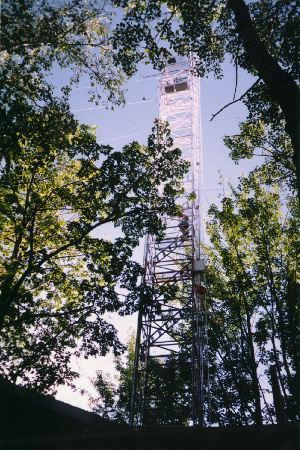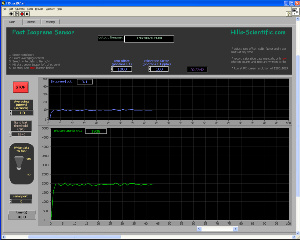Fast Isoprene Sensor
 Hills-Scientific is pleased to offer the Fast Isoprene Sensor (FIS) to the research community. Fast Isoprene Sensors in use worldwide provide continuous isoprene monitoring from <1 ppb in atmospheric studies to ppm levels in biological and medical research.
Hills-Scientific is pleased to offer the Fast Isoprene Sensor (FIS) to the research community. Fast Isoprene Sensors in use worldwide provide continuous isoprene monitoring from <1 ppb in atmospheric studies to ppm levels in biological and medical research.
The sensors are used in chamber and cuvette studies as continuous monitors supporting fundamental photosynthetic and process research. They routinely measure atmospheric isoprene and have been used for many years in eddy-covariance flux studies.
The FIS is based on chemiluminescence. Isoprene/ozone chemiluminescence measurement is extremely sensitive as the reaction has a high quantum efficiency for light production in addition to the light appearing on a near-zero background and since single-photon counting detection is used in all our instruments.
Custom LabVIEW software controls the photon counting and displays the chemiluminescence signal and isoprene concentration (ppb) in real-time as well as archiving the data. The FIS signal is linear over all typical measurement regimes (4 orders-of-magnitude concentration range) allowing simple data interpretation and easy one or two point calibration.
A microprocessor controller automatically zeros and calibrates the instrument on a user defined schedule using ultra-clean pneumatically controlled valving. Electronic mass-flow controllers control all gas flows and monitor reaction cell pressure. Flows, pressure, and instrument status signals are available as outputs.
The instruments are designed using 3-D CAD and housed in custom 6061 chassis boxes which are fabricated to mil-spec and powder-coated. Graphics are then silk screened on using epoxy paint. In short, every detail of the Fast Isoprene Sensor is designed to deliver high performance in a bombproof and easy to service instrument.
–We build them to last a lifetime–
Features
The Fast Isoprene Sensor is the product of 20 years of continuous development. Every component has been designed and selected for superb performance and rugged durability.
Features Include:
Close-coupled optics
All stainless/Teflon flow paths
Single photon detection
Custom LabVIEW software
Electronic mass flow control
Four channel RTD digital temperature control incorporating Aerogel insulation
Microprocessor or external PC controlled autocalibration
Integral platinum catalytic ultra-clean air generator
Shock-mounted silent brushless DC pump
Ultra-clean pneumatic valving
Bombproof 6061 alloy custom chassis built to mil-spec, powder coated, epoxy graphics
Lifetime construction
Specifications
Response time: 0.4 seconds to 90% full scale
Sensitivity: 200 parts per trillion @ S/N=1
Linearity:10,000
Sensitivity to RF interference: minimal
Sensitivity to vibration: negligible
Sample flowrate: 0.150-4.00 Liters/minute
Weight: 18 kg (40 lbs)
Power consumption: 170 W
Voltage: 90-250 VAC
FIS Software
 The Fast Isoprene Sensor uses an optical detection system which is controlled through serial communication. Hills-Scientific provides free LabVIEW software to operate the FIS. The software displays the FIS signal and also plots isoprene concentration as a function of time using user settable calibration parameters.
The x-axis (time base) and y-axes (photon counts per second and isoprene concentration), are scalable on-the-fly. It also archives the raw signal and time data in a format usable with Excel and all common analysis software.
The software is available in both executable form (stand alone) and as LabVIEW source code. The source code version can be completely customized for your particular application. The software runs at user selectable rates from 10-Hz (0.1 second integration) for eddy covariance applications to the longer integrations appropriate for growth chamber research (1-10 seconds or longer). All FIS software is complimentary and available on CD, or via e-mail or FTP transfer.
The Fast Isoprene Sensor uses an optical detection system which is controlled through serial communication. Hills-Scientific provides free LabVIEW software to operate the FIS. The software displays the FIS signal and also plots isoprene concentration as a function of time using user settable calibration parameters.
The x-axis (time base) and y-axes (photon counts per second and isoprene concentration), are scalable on-the-fly. It also archives the raw signal and time data in a format usable with Excel and all common analysis software.
The software is available in both executable form (stand alone) and as LabVIEW source code. The source code version can be completely customized for your particular application. The software runs at user selectable rates from 10-Hz (0.1 second integration) for eddy covariance applications to the longer integrations appropriate for growth chamber research (1-10 seconds or longer). All FIS software is complimentary and available on CD, or via e-mail or FTP transfer.
References
Eddy covariance measurement of isoprene fluxes (PDF), Alex Guenther and Alan Hills (used an early version of the Fast Isoprene Sensor)
Fast Isoprene Sensor web search, ~5600 Google hits
H. Westberg, B. Lamb, R. Hafer, A. Hills, P. B. Shepson, and C. Vogel, Measurement of Isoprene Fluxes at the PROPHET Site, J. Geophys. Res., 2001, 106, D20, 24, 347-358.
Dennis J. Barket, Jr., Julia M. Hurst, Tara Lin Couch, Armando Colorado, Paul B. Shepson, Daniel D. Riemer, Alan J. Hills, Eric C. Apel, Rae Hafer, Brian K. Lamb, Hal H. Westberg, Charles T. Farmer, Erik R. Stabenau , Rod G. Zika, Intercomparison of automated methodologies for determination of ambient isoprene during the PROPHET 1998 summer campaign, J. Geophys. Res., 2001, 106, D20, 24, 301-313.
Zimmer W., Brüggemann N., Emeis S., Giersch C., Lehning A., Steinbrecher R. & Schnitzler J.-P. (2000): Process-based modelling of isoprene emission by oak leaves. Plant, Cell and Environment 23, 585-595.
Brüggemann N. & Schnitzler J.-P. (2001) Influence of powdery mildew (Microsphaera alphitoides) on isoprene biosynthesis and emission of pedunculate oak (Quercus robur L.) leaves. Journal of Applied Botany, in press.
Alan J. Hills, John W. Birks and Donald H. Lenschow, Fast Dimethyl Sulfide (DMS) Measurement by Fluorine-Induced Chemiluminescence, Analytical Chemistry, 1998, 70, 1735-1742. (used FIS to monitor DMS to 10 pptv with fluorine in place of ozone as the chemiluminescing reagent)
Bowling, D.R., A.A. Turnipseed, A.C. Delany, D.D. Baldocchi, J.P. Greenberg, R.K. Monson, The use of relaxed eddy accumulation to measure biosphere-atmosphere exchange of isoprene and other biological trace gases, Oecologia, 1998, 116, 306-315. (used FIS as the reference method to test an emerging flux technique)
Russ K. Monson, Alan J. Hills, and Ray R. Fall, Methods for the Analysis of Isoprene from Leaves, textbook chapter: Springer-Verlag, D. Czeschlik Ed., Modern Methods of Plant Analysis, Volume 13, 1992.
Guenther, A., R. Monson and R. Fall, Isoprene and Monoterpene Emission Rate Variability: Observations with Eucalyptus and Emission Rate Algorithm Development, J. Geophys. Res., 96 (D6), 10799-10808, 1991.
Russ K. Monson, Alan J. Hills, Patrick R. Zimmerman, Ray R. Fall, Studies of the relationship between isoprene emission rate and CO2 or photon-flux density using a real-time isoprene analyzer, Plant Cell & Environment, 1991, 14, 517-23. (first use of FIS for measurement of isoprene in a single-leaf chamber study)
Alan J. Hills and Patrick R. Zimmerman, Isoprene Measurement by Ozone-Induced Chemiluminescence, Analytical Chemistry, 1990, 62, 1055-60. (first FIS reference)
